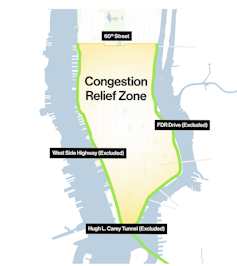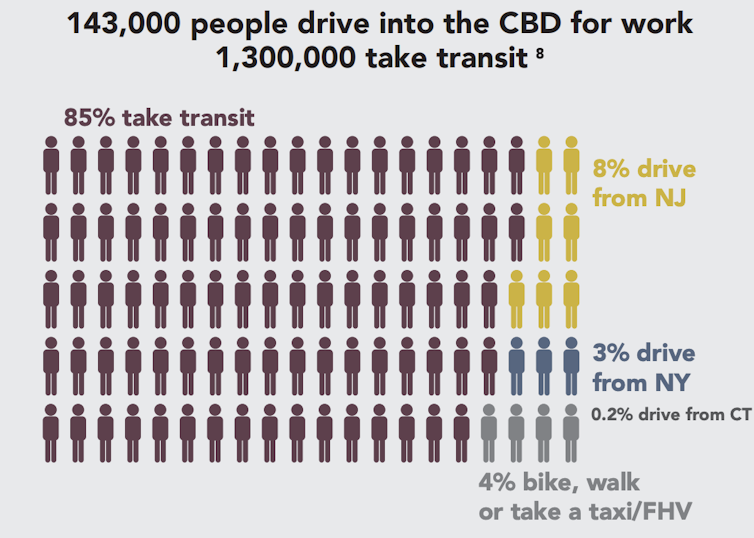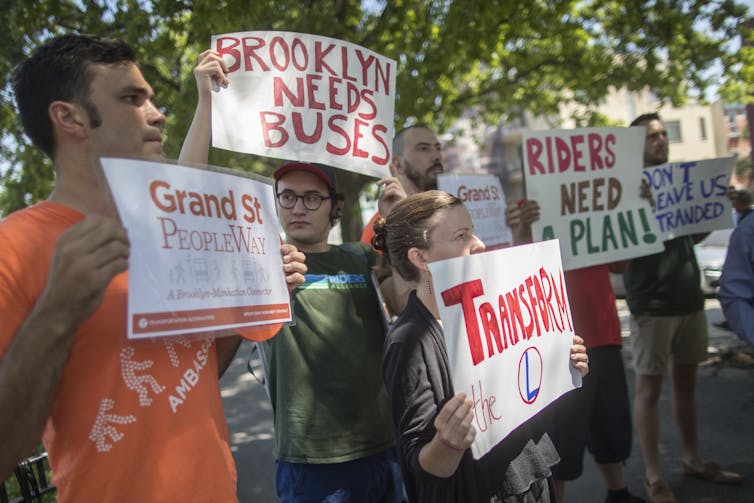New York Metropolis is poised to launch the primary congestion pricing plan to scale back visitors in a serious U.S. metropolitan space. Like many journeys within the Huge Apple, this one has been punctuated by delays. As soon as the system begins up, nonetheless, it’s anticipated to considerably cut back gridlock in Manhattan and generate billions of {dollars} to enhance public transit citywide.
The fundamental thought is easy. To enter the Congestion Aid Zone, which covers Manhattan south of sixtieth Avenue, massive vehicles pays $36, small vehicles $24, passenger automobiles $15 and bikes $7.50. Experience-share automobiles and taxis pays $2.50 and $1.25, respectively. Peak hours run from 5 a.m. to 9 p.m. on weekdays and 9 a.m. to 9 p.m. on weekends; in a single day tolls are discounted by 75%.
Proof from cities all over the world reveals that charging motorists charges for driving into metropolis facilities throughout busy intervals is a rarity in city public coverage: a measure that works and is cost-effective.
Congestion pricing has succeeded in cities together with London, Singapore and Stockholm, the place it has eased visitors, sped up journey occasions, lowered air pollution and supplied funds for public transportation and infrastructure investments.
As an city coverage scholar, I’m trying ahead to seeing New York’s plan go into impact. There might be surprises and changes as officers see the way it works in follow. However given the heavy prices that visitors imposes on public well being and productiveness, I’m inspired to see a serious U.S. metropolis lastly take a look at this strategy.
Nudging drivers
Congestion pricing is a response to externalities – prices or advantages which might be generated by one occasion however incurred by one other. Clogged metropolis streets and air air pollution are externalities created by city automobile customers, a lot of whom dwell outdoors town.
This idea has been round for a while. British economist Arthur Pigou mentioned it as early as 1920 as a part of his try and treatment the suboptimal workings of the market system. In Pigou’s view, taxing dangerous actions would discourage folks from participating in them.
Different thinkers took up this concept. In 1963, Canadian economist William Vickrey, a future Nobel laureate, argued that roads have been scarce sources that wanted to be valued by imposing prices on customers.
This strategy is behind behavioral economics, the coverage technique of utilizing “nudges” that protect alternative however encourage sure actions. Congestion pricing assumes that elevated costs will make folks heading into New York suppose extra fastidiously about their journey patterns, and about alternate options to driving.

Public transit receives precedence
Congestion pricing in a metropolis an enormous as New York is not any small step. The New York plan was offered to the board of the Metropolitan Transit Authority in November 2023 after years of research and an in depth environmental affect evaluation, required by federal legislation.
Venture sponsors, which embrace a number of metropolis companies and the state transportation division, acknowledged within the affect evaluation that on a mean weekday, an estimated 1.86 million folks entered decrease Manhattan by motorized vehicle. Journey speeds in Manhattan’s central enterprise district, beneath sixtieth Avenue, declined by 23% between 2010 and 2019, from 9.1 to 7.1 mph. The visitors was producing air and noise air pollution, losing vacationers’ time, rising enterprise prices and stopping emergency automobiles from responding rapidly to accidents.
The companies estimated that the proposed toll system would cut back visitors within the Congestion Aid Zone by 17%, with an related decline in air air pollution. It additionally would generate US$15 billion for capital enhancements to town’s public transit system, together with making stations accessible for passengers with disabilities and shopping for new electrical buses and commuter rail and subway automobiles.
Greater than 75% of all journeys into the central enterprise district are made by public transit. The system has been suffering from breakdowns over the previous decade. The Metropolitan Transit Authority lately adopted a $52 billion capital enchancment program to replace its community, some components of that are greater than 100 years previous.

Over a number of months of public hearings, the MTA heard each broad assist for congestion pricing and hundreds of requests for credit, reductions and exemptions, most of which have been denied. The restricted variety of exemptions contains non-public commuter buses, faculty buses and city-owned automobiles, together with emergency automobiles.
As well as, drivers who journey through Franklin D. Roosevelt Drive on Manhattan’s jap edge, the West Facet Freeway on its western edge, or the Carey Tunnel between Brooklyn and Battery Park is not going to be charged if they don’t enter any avenue within the Congestion Aid Zone. Drivers from the Bronx, Queens and Staten Island will likely be eligible for rebates and reductions on sure bridge tolls.
There have been widespread complaints from New Yorkers within the outer boroughs of the Bronx, Brooklyn and Queens, and from automobile commuters who dwell outdoors of town. New Jersey is suing the MTA, arguing amongst different issues that the plan is unconstitutional as a result of it burdens interstate commerce. This go well with may delay the beginning of congestion pricing.
Nonetheless, the board adopted the plan with only one dissenting vote, from a consultant of Nassau County on Lengthy Island.

Beginning the journey
Many questions will solely be answered as soon as the system begins up in June 2024, or later whether it is delayed by lawsuits. Will toll costs be excessive sufficient to spur folks to change to a different mode of transportation or mix journeys, whereas nonetheless producing sufficient income for the MTA’s formidable capital enchancment program? How will toll income be spent? And the way will commuters reply after they discover that trains and subways initially are extra crowded, earlier than capital upgrades enhance the system?
Some low-income and minority communities that already expertise heavy visitors, such because the Bronx, may see elevated congestion as drivers detour across the toll zone. To assist mitigate a few of these results, the transit authority is planning to speculate thousands and thousands of {dollars} to scale back air pollution in these environmental justice areas by steps reminiscent of putting in air filters in colleges, planting extra timber and electrifying vehicles on the large Hunts Level Meals Distribution Heart within the Bronx.
Nobody likes to pay for one thing that was beforehand free. However freedom for automobile customers has imposed well being and financial prices on thousands and thousands of New Yorkers for a few years. Congestion fees do increase fairness points, however solely 5% p.c of people that commute into the central enterprise district journey by automobile, and most of these drivers have comparatively excessive incomes.
The MTA might have to regulate tolls, the zone’s borders or different facets of the plan. But when New York’s experiment succeeds, it may present a mannequin and worthwhile insights for different traffic-clogged U.S. cities.![]()
John Rennie Brief, Professor Emeritus of Public Coverage, College of Maryland, Baltimore County
This text is republished from The Dialog below a Inventive Commons license. Learn the unique article.
